The succulent craze shows no signs of slowing down, and why would it? Succulents come in a vast array of structural designs and colors that make these plants endlessly interesting. And on top of that, virtually all succulent plants require surprisingly little care to yield big results. So the popularity of these plants is well-deserved, and few are more popular than rosette succulents.
Rosette is not a formal classification of succulent but a colloquial reference to succulent plants whose leaves grow in a shape and form similar to the rose flower. Hence their name: rosette. (And rosettes aren’t limited to succulents. Other plants have rosette-shaped leaf formations.)
This makes rosette succulents popular for indoor containers as well as outdoor gardens. But that’s just the beginning. Rosette succulents are showing up everywhere. They’re even becoming a popular choice for wedding bouquets and boutonnieres!
But the leaf structure of rosette succulents isn’t just about aesthetic appeal. There is a functional purpose behind these splendid rosette arrangements. The fleshy leaves that grow in an upward, circular pattern help the plant harness maximum sunlight. The leaves also help to funnel water down to the roots.
It would be nearly impossible to produce an exhaustive list of rosette succulents since new hybrids and cultivars are constantly being developed. Nevertheless, there are some well-established and wildly popular rosettes that every succulent gardener needs to know. Let’s talk about five of those robustly renowned rosettes!

Miniature rosette succulent plants in a garden
©iStock.com/alpssimon
Echeveria
The Echeveria succulent is probably the most widespread and well-known rosette succulent. Their native range includes Central America, South America, Mexico, and even extends into Texas.
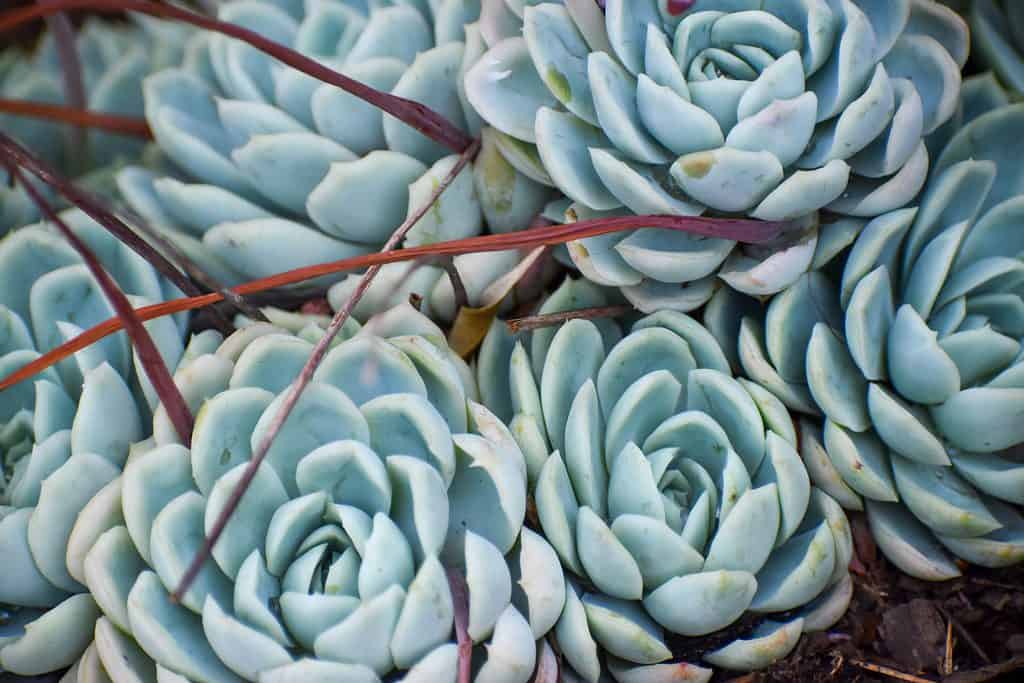
Mexican snowball succulent (
Echeveria elegans) flowering.
©Prodromos_1/Shutterstock.com
The Echeveria plant’s leaves grow in a classic rosette pattern. Echeveria plants come in a variety of colors, including pink, white, orange, red, green, and yellow. The rose-patterned leaves and the color variety really do give this succulent a rosy, floral appearance.
Echeveria is a large genus with more than 180 species and over 1,000 cultivars, so the options for planting and display are practically limitless.
While exceptions exist, most Echeveria species remain small, growing no larger than 12 inches in width and height. The leaves often appear tough but are actually rather sensitive. Some varieties have a leaf coating called farina. The leaves can be marred if the farina coating is disturbed.
One of the most popular Echeveria succulents is the “hens and chicks” (Echeveria imbricata), a small hardy succulent with tightly compacted rosettes of fleshy, blue-green leaves. This plant produces offsets freely, hence the common name. The offsets (chicks) hug the mother plant (hen), creating overlapping circles.

Top view of hens and chicks plants (
Echeveria imbricata)
©Gonzalo de Miceu/Shutterstock.com
Aloe
Native to sub-Saharan Africa and Madagascar, Aloe is a genus with over 500 species of perennial succulents. The one that everyone knows, of course, is Aloe vera due to its use in the therapeutic, cosmetic, and pharmaceutical industries.

plant in a black pot
©iStock.com/klenova
Most Aloe species have thick succulent leaves growing in a rosette pattern. Some species remain small and make wonderful houseplants. For example, the short-leaf aloe (Aloe brevifolia) usually maxes out around four inches tall.

The small
Aloe brevifoliaplant in a pot
©Golga101/Shutterstock.com
Other Aloe species can grow quite large. The tilt-head aloe (Aloe speciosa) rivals the size of a tree, growing upwards of 15 feet tall, with a rosette of three-foot-long leaves atop its trunk.

The large
Aloe speciosaplant with flower cones
©demamiel62/Shutterstock.com
Obviously, it’s important to research the Aloe species you are considering to ensure you have the required space. It’s doubtful that you want a 15-foot-tall houseplant.
Aeonium
Smaller than Echeveria or Aloe, Aeonium is a genus of around 35 species of succulents. Most are slow-growing plants, taking as long as five years to mature.

Beautiful green-pink kiwi aeonium
©ArliftAtoz2205/Shutterstock.com
Sometimes known as “tree houseleeks,” aeoniums are native to northern Africa and islands like Madeira, the Cape Verde Islands, and the Canary Islands.
Many Aeonium species are known for their immaculate rosette leaf patterns. The leaves are often so perfectly shaped and arranged that the plants are mistaken for factory-made plastic plants. But they are very real and very beautiful.
Aeoniums vary in size, depending on the species. The dwarf aeonium (Aeonium sedifolium) is the smallest in the genus, growing to a height of 15 inches with leaf rosettes that measure a little over an inch in diameter.

Top view of the dwarf aeonium (
Aeonium sedifolium)
©Christina Siow/Shutterstock.com
The saucer plant (Aeonium undulatum) is the largest of the aeoniums. It is a shrub that can grow over six feet tall and three feet across, with a large green rosette measuring nearly a foot in diameter.

Large saucer plants (
Aeonium undulatum) growing out of rock
©Ergfoto/Shutterstock.com
Sempervivum
This genus of around 40 species is popular because of their lovely rosettes combined with their extreme ease of care. Most Sempervivum species thrive in harsh conditions, with many producing offsets every year (a propagator’s dream!).
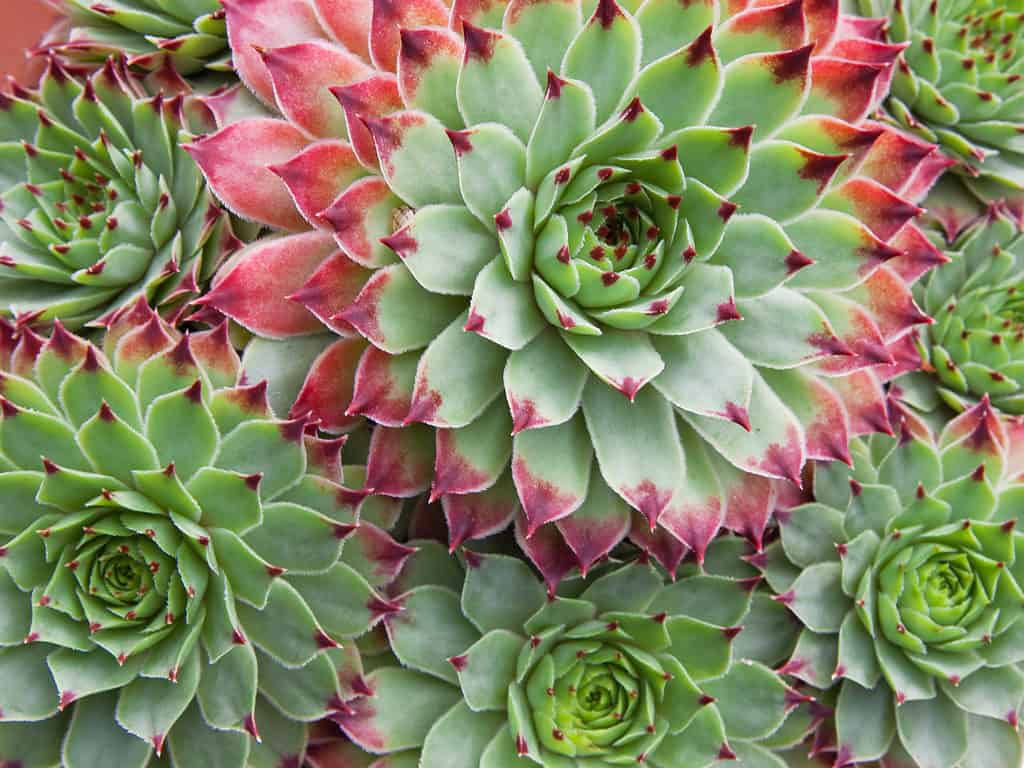
Green leaves with red tips of
Sempervivum hirtumplants
©iStock.com/pjhpix
Commonly known as “houseleeks,” Sempervivum succulents are alpine plants native to southern Europe and western Asia, hence their proliferation in rocky, nutrient-poor soil.
It’s worth noting that Sempervivum succulents are often confused with Echeveria plants. Of course, it doesn’t help that both genera include varieties commonly referred to as “hens and chicks.”
Echeverias are native to the Americas, while sempervivums hail from Europe and Asia. But you don’t have to check their passports to tell the difference. Upon closer examination, each plant’s distinctiveness can be seen. For example, echeverias have thicker and wider spoon-shaped leaves, while sempervivums feature narrower leaves with pointed tips.
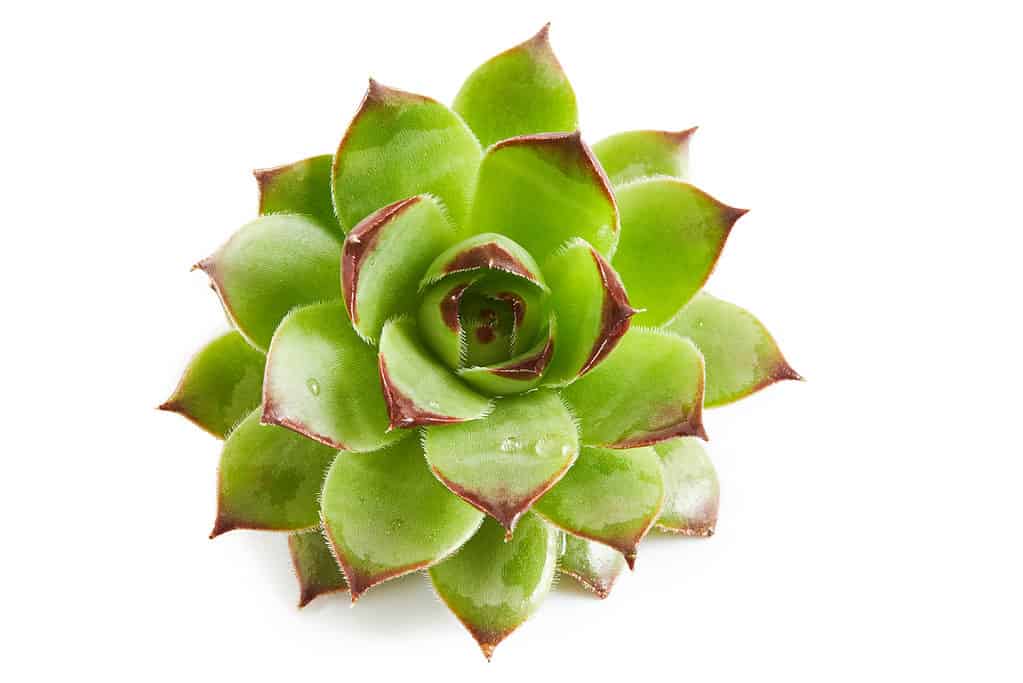
Top view of a common Houseleek (
Sempervivum tectorum)
©Nedim Bajramovic/Shutterstock.com
The most popular species in the Sempervivum genus is the “common houseleek” (Sempervivum tectorum). It features fabulous green rosettes with rose-colored edges.
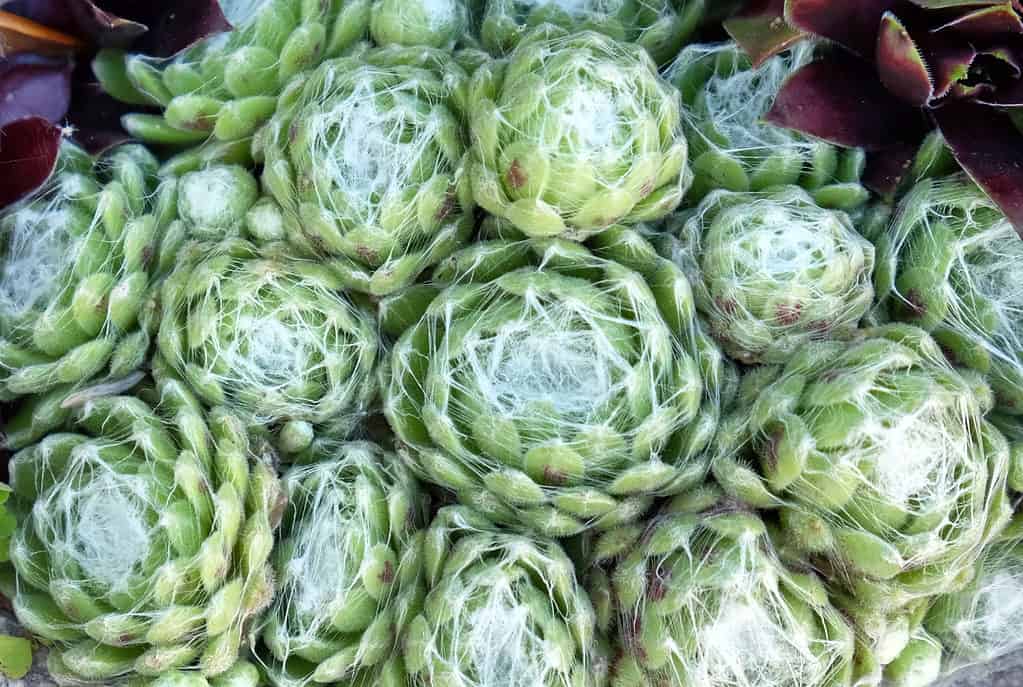
The webbed look of the cobweb houseleek (
Sempervivum arachnoideum)
©Alex Manders/Shutterstock.com
Then there is the unique Sempervivum arachnoideum, commonly known as the “cobweb houseleek.” This plant’s green rosette has white hair-like fibers at the tips, which look like cobwebs.
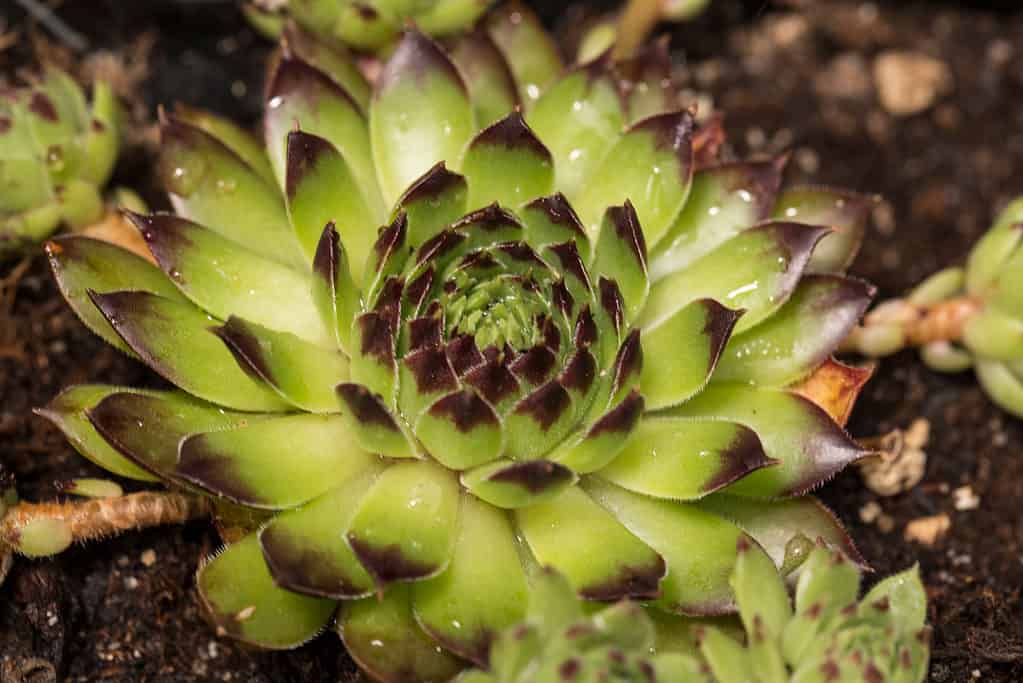
Sempervivum Black Top succulent plant with beautiful green leaves with black tips
©limipix/Shutterstock.com
Another unique beauty in the genus is the Sempervivum black top succulent. As its name suggests, its green leaves have gorgeous black tips, making it a standout in any home or garden.
Agave
Many of the nearly 200 Agave species are native to hot, dry areas of the Americas and the Caribbean. Most agaves are succulents featuring rosettes of large leaves with pointed, spiny tips, although variations within the genus exist.
Many Agave species are slow-growing but also long-lived. Some are particularly famous for their culinary and libation uses.
For example, blue agave (Agave azul) is the primary ingredient in tequila.

Field of blue agave plants in Mexico
©javarman/Shutterstock.com
But the uses of agave don’t stop at distilled liquor. Agave is also used to make a sugar alternative. In addition, the flowers, leaves, stalks, and sap of agave plants have been used as cooking ingredients for thousands of years. (It’s important to note that raw agave sap is toxic to both humans and pets.)
The versatility and multiple uses of agave shouldn’t overshadow one more feature of these succulents: they are fantastic ornamental additions to your home or garden!
For instance, the foxtail agave (Agave attenuata) has a silver and pale green rosette resembling a fox’s tail. However, unlike many other agave species, it has no spines or teeth.
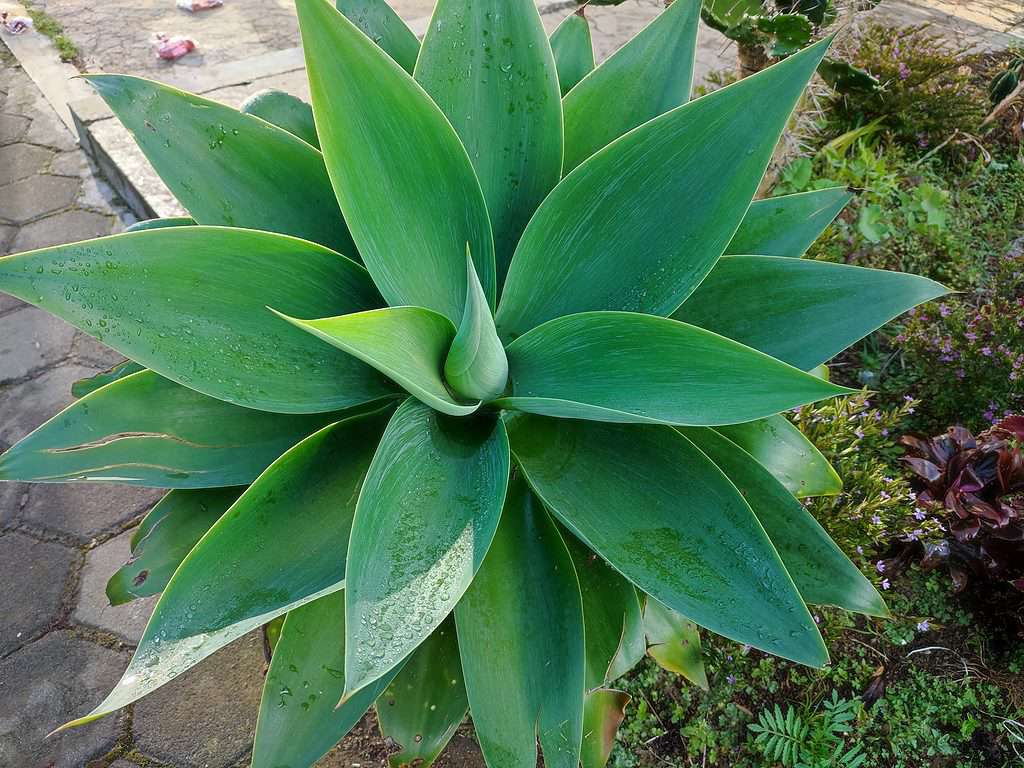
Top view of a beautiful foxtail agave (
Agave attenuata)
©Panji.Art/Shutterstock.com
The Caribbean agave (Agave angustifolia) features a rosette of pale green leaves with cream-colored edges that can grow up to two feet long.

Caribbean Agave (
Agave angustifolia) with its trademark green leaves with cream edges
©iStock.com/kitsana0756
The whale’s tongue agave (Agave ovatifolia) is a rare cold-hardy agave species. The bluish-colored thick leaves give the plant its common name.

Side view of a whale’s tongue agave plant (
Agave ovatifolia) basking in the sun
©Tracy Immordino/Shutterstock.com
Care
Regardless of which rosette succulent you choose, the required care is similar to that of most succulent plants (though it’s important to remember that in a grouping as large and informally assembled as rosette succulents, exceptions and variations are to be expected).
Here are some general guidelines to keep in mind.
Sunlight
Most succulent plants require partial to full sun. Six hours of sun a day is a good rule of thumb.
Soil Type
Like other succulents, most rosette succulent plants must be planted in well-draining soil. Overwatering is a death sentence to most succulents as it leads to root rot.
Rocky, sandy soil is where the majority of succulents thrive. You can’t go wrong if you use a succulent or cactus soil mix. If you want to mix your own, you can mix three parts of regular potting soil with two parts of sharp sand and perlite.
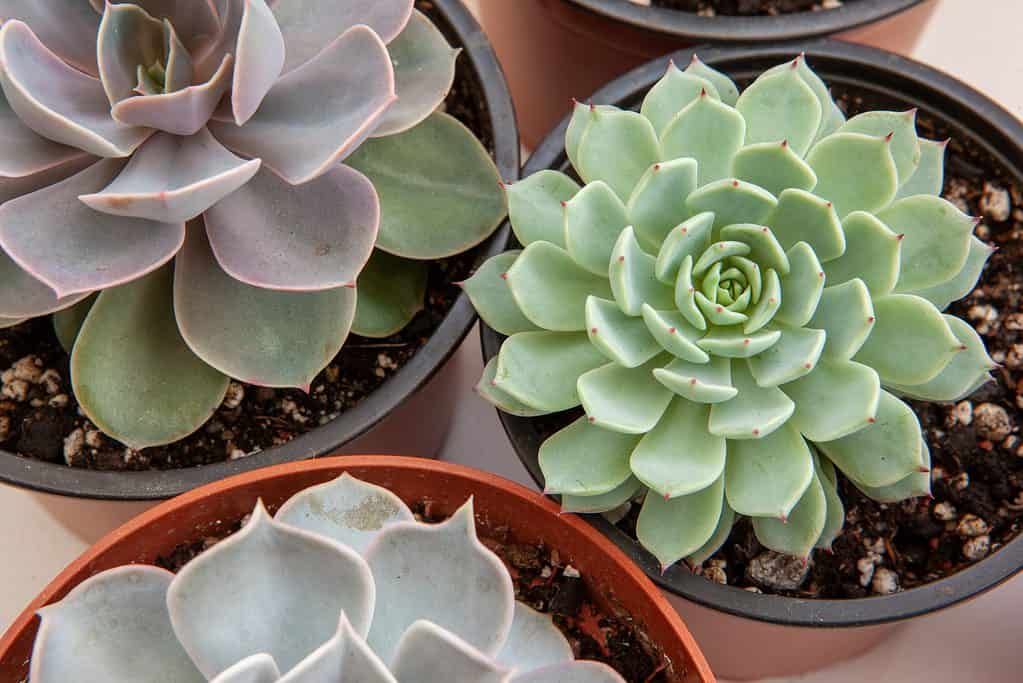
and
Sedumrosette succulents potted in a rocky/sandy soil mix
©vveronka/Shutterstock.com
Water
Watering needs can vary, but the most important thing is not to overwater your succulent.
If planted in an outdoor garden, you will need to water sparingly and sometimes not at all.
For indoor succulents, the general rule is to check the top inch of the soil. If it’s completely dry, soak the roots of the plant (not the leaves). Make sure your container has drainage holes. Don’t water again until that top inch of soil completely dries.
It is impossible to give comprehensive guidelines for a grouping this large, but when it comes to watering, remember this: underwater when in doubt. Succulents store water in their leaves and are drought-tolerant. They can bounce back quickly from dry spells, but they won’t bounce back at all from root rot caused by too much moisture.
Placement
Sun is critical for most succulents. Choose a spot that gets plenty of sun, preferably in the morning. In hotter climates, the direct afternoon sun can scorch some succulents.
Most succulent plants thrive in hot, dry conditions. There are exceptions in the rosette grouping. For example, the whale’s tongue agave can handle colder temperatures than many other succulents.
If you live in a colder zone, though, it’s best to plant succulents in containers that can be moved inside during cold weather or just grow them as year-round houseplants. You’ll need a sunny window or possibly grow lights if there is not enough sun access.
Common Problems
We’ve already covered the most common issue when growing succulents: overwatering.
Succulents are vulnerable to certain pests, as well. For example, mealybugs, scale, and aphids can all be problematic.
Neem oil, insecticidal soap, or diluted rubbing alcohol can get rid of these unwanted and destructive insects.
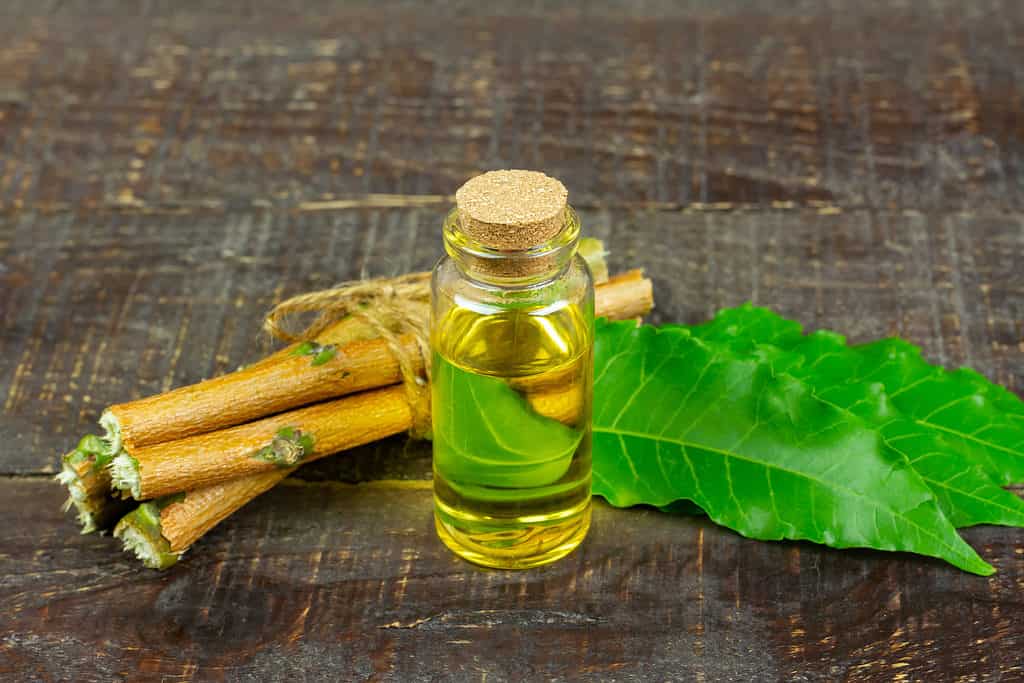
Neem oil is effective in ridding succulents of pests.
©iStock.com/Ninetechno
As always, research the specific rosette succulent you choose to prepare for its specific care needs. But the good news is that, for the most part, the care needs are minimal. It’s usually not difficult to grow thriving rosette succulents in your home or garden, so give it a try!
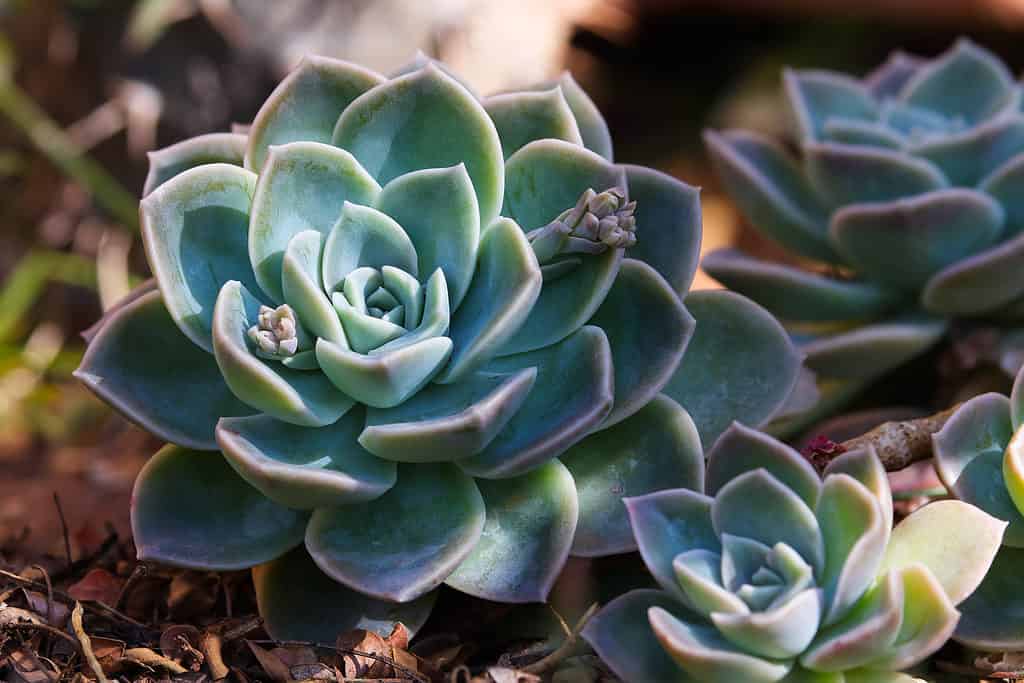
Succulent blue rock rose (
Echeveria imbricata) plant growing in a garden.
©iStock.com/JJ van Ginkel
The photo featured at the top of this post is © Joshua Small-Photographer/Shutterstock.com
Thank you for reading! Have some feedback for us? Contact the AZ Animals editorial team.






